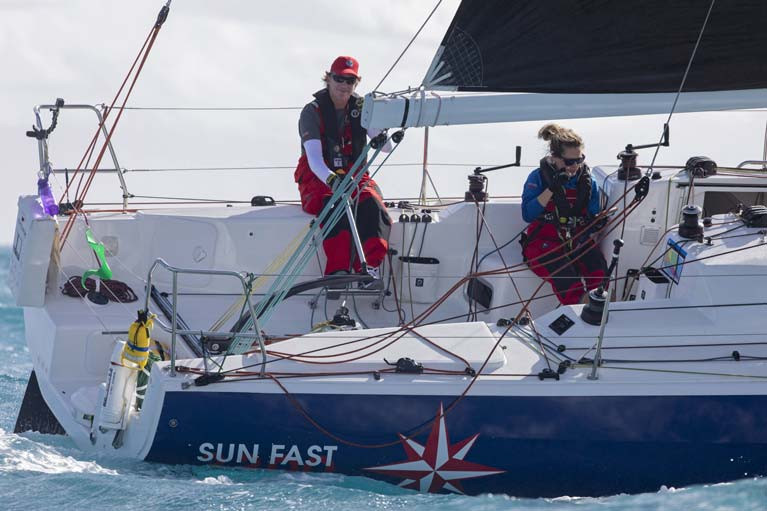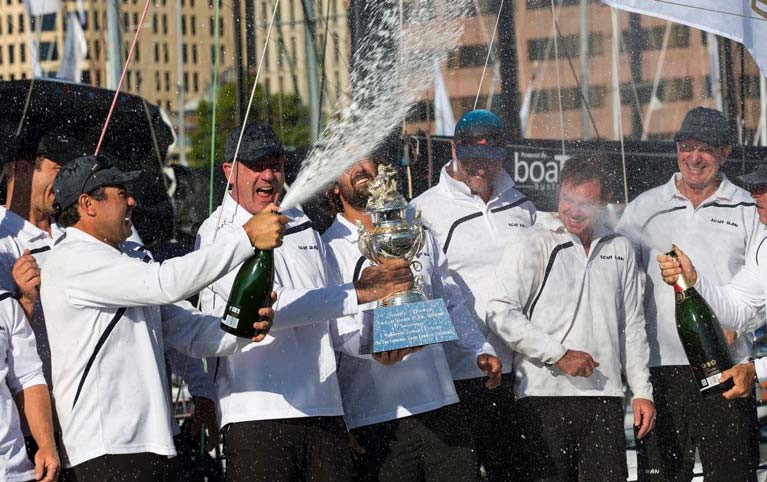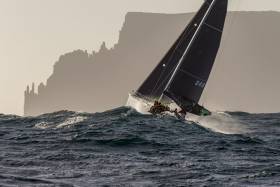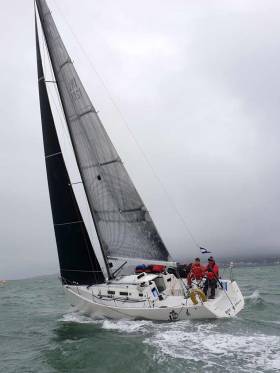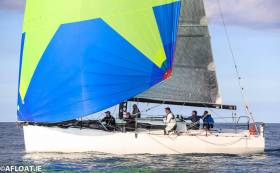Displaying items by tag: North Sails Ireland
North Sails Go Mixed Short Handed Sailing
North Sails have recently teamed up with Beneteau in the USA to work together and promote shorthanded sailing writes Nigel Young.
Our own company president Ken Read has been leading from the front and getting stuck into this existing segment of sailing.
Here in Ireland, the short-handed sailing is growing in popularity and we have been involved in quite a few projects in recent months.
The sail requirements for these boats are quite different to "round the cans" inshore racing sails and generally they have to cover a much wider wind range than an inshore sail.
This is an area where the 3Di sails really score over the opposition. For their strength, 3Di is lighter than anything else on the market so you can still have a sail that's happy to fly in its designed shape in 12 knots TWS and choppy water but it is also strong enough to be reefed and used right up the range.
Reefs in Headsails are not uncommon and all sorts of other little tricks to make it easy to handle the sails when you can hardly keep your eyes open!
3Di copes better with rough handling and of course as you all know there is no plastic film to crack in 3Di sails which keeps them out of the service loft.
In fact, we have seen a major reduction in service work on the 3Di sails, some clients have 4-5-year-old sails that have never even seen the service loft!
For the full story please take a look at the article here
North Sails Ireland & The Sydney Hobart Winner 'Ichi Ban'
It was fantastic to see "Ichi Ban" win IRC overall in the Sydney Hobart race last week writes Maurice O'Connell. I raced this iconic race some years back on the IMX 40 "Nips 'n Tux" and it is a true classic offshore race.
"Ichi Ban" was powered 100% by North Sails and had NS colleagues Rob Greenhalgh and sail designer Dick Parker aboard. Here in North Sails Ireland, we have worked with "DP" on numerous projects over the years.
Most recently, these included including Brendan Coglan's Jeanneau Sunfast 3600 "YoYo", John O'Gorman's SF 3600 "Hot Cookie" and Seamus Fitzpatrick's Beneteau First 50 "Mermaid IV".
Rob Greenhalgh is also no stranger to Irish sailing having been a member of the Rolex Commodore's Cup-winning team on Anthony O'Leary's giant-killing Ker 39 "Antix" - also 100% powered by North Sails!
It was also great to see Howth man and "Ichi Ban" sailing master Gordon Maguire win his 4th "Hobart" - nice one Gordon!
Please click here for further info on "Ichi Ban"s Tattersall's Cup overall IRC victory.
North Sails Ireland 2019 Victory List
2019 was another fantastic year for North Sails Ireland. Our clients seem to be going faster and faster - for longer writes Maurice O'Connell.
Many of you are winning events with our sails that have seen many many seasons use already. Well done everyone!
The North Sails Ireland team would like to thank all our customers (and not just the winners) most sincerely for their great efforts on the water in 2019. We wish you all a very merry Christmas, a peaceful and happy new year and see you on the water in 2020.
Click on this link here to take you to our 2019 Victory List.
Sail FAST.
Nigel, Shane, Richard and Prof.
North Sails Success at Moth Worlds
I've just been looking at the results from the Moth Worlds and have been following the progress of the Irish guys all week, so I thought I would share this with you writes Nigel Young.
Earlier in the year, we talked about the trickle-down effect of 3Di in small boat sails. Here is a great example of 3Di excelling in small boats.
Tom Slingsby just decimated the fleet in Perth using the very latest 3Di deck sweeper mainsail and seven of the top 10 boats were using 3Di sails!
Amazing to think how far this product has come in such a short time! Super Yachts to Moths and anything in between.........If you want to win you need to be flying 3Di, there is nothing else like it! Not even close.........
Check out the link here to get the thoughts of the new World Champion.
SAIL FAST and Happy Christmas from us all at North Sails Ireland
Tips for Reefing from North Sails Ireland
Here in Ireland the Coastal, ISORA and short-handed sailing is growing rapidly in popularity writes Nigel Young.
Unlike Inshore racing these days in Ireland where I have not reefed in over 10 years the need to reef when sailing offshore or shorthanded is a different story altogether.
Sailing in big breeze can be fun, exciting, maybe stressful, and sometimes expensive when things go wrong. Shortening sail quickly and easily when the breeze comes on is key to looking after your sails and your crew. Last year’s Rolex Sydney Hobart Yacht Race saw many teams forced to retire after suffering sail damage on the first evening’s southerly change. So in the lead up to this year’s race, one of my colleagues from North Sails Australia wrote a short piece on the subject and I felt it was well worth sharing. I hope you agree.
Here's the link to the story here
Sail FAST
North Sails Ireland
North U Programme Turns Sailors Into Racers & Racers Into Winners
North Sails Ireland have enjoyed a strong connection with Bill Gladstone and the North U program over the last few years.
Back in the early years of North Sails Ireland Bill came over and did two tours of duty around the Island of Ireland as our politicians like to say!
I was looking at the revamped North U website only this morning and thought it would be good to share this with all the Afloat readers.
North U has been in existence for many years now and these guys really know their stuff. There is so much information on the site its really worth a read to see if there is anything specific you and your crew can take from the North U Team.
There are also plenty of Free Downloads here to give you a real taste of what North U is all about.
Being part of the North Sails Family it's not all about selling sails and results. Education is top of the list for North Sails and you can see that online and in the field.
When you buy a North Sail you are working with experts and part of the fun of the job is educating our customers to improve their sailing and performance.
Thanks to Bill Gladstone and the team at North U we have some resources to share with you and your crew.
SAIL FAST
North Sails Ireland
In celebration of the Cork 300 Regatta in 2020 North Sails are offering a very special deal for the 1720 fleet. For all sails ordered before the end of December 2019 North Sails Ireland are offering savings on the full range of sails.
North Sails have been involved in the 1720 class since its inception and our sails have enjoyed some great results over the years. We were delighted to see our 3Di sails at the front of the fleet in 2019 and the feedback has been excellent.
In recent times things have been a little quiet in the class but with the 1720 Europeans forming part of the Cork 300 celebrations, it seems like every 1720 within a 400 miles radius will be joining the fleet in 2020!
So with that in mind, we decided to make a one-time special offer to the class to allow more teams to experience what North Sails and 3Di can do for you.
For prices and terms please do not hesitate to contact us at: [email protected]
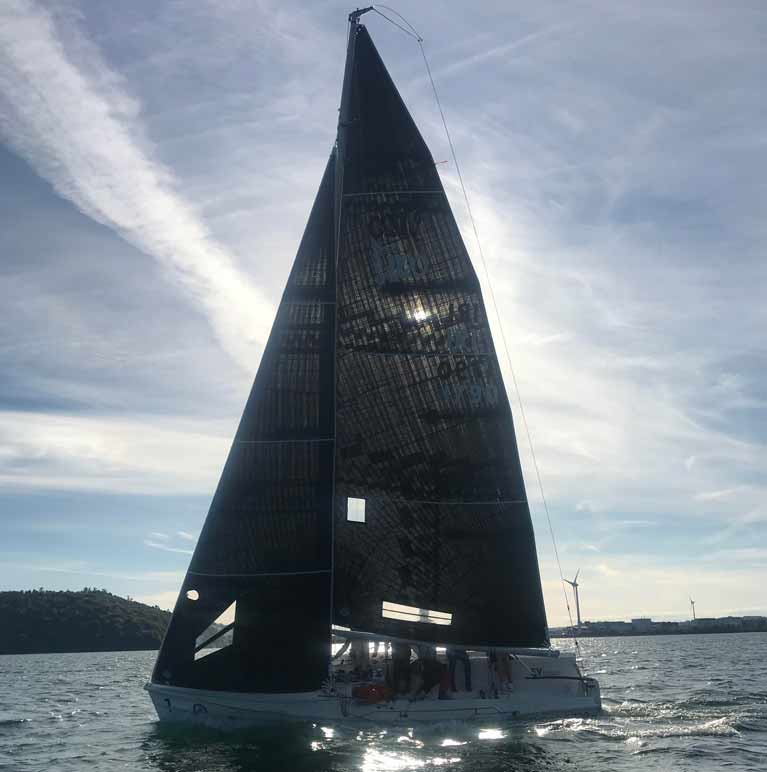
We look forward to hearing from you very soon.
Offer ends 31st December 2019.
North Sails & the Under 25 Teams
Here at North Sails Ireland, there is nothing we like more than working with the under 25 sailing teams all over the country. This is a growing segment in Irish sailing and we are delighted to be involved from the very start.
Having been personally involved with the RCYC and FYC Teams during 2019 there is a nice steady growth in this area and it's fantastic to be at Keelboat regattas surrounded by so many young people. This year's J-24 National in Lough Erne was a great example with six under 25 teams at the regatta. It changes the whole dynamic of the event and adds a layer of fresh enthusiasm for our sport.
This segment is not all about winning, its main objective is to keep people in the Sport and offer them a place to race and opportunities to experience One Design keelboat sailing. Having said that I am sure with the right equipment and the correct level of funding it will not be long before we see more under 25 teams taking the silverware home.
It appears that the J-24 is emerging as the boat of choice in many clubs and with this, in mind, I wanted to share a story from the current world champions: World Championship winners debrief.
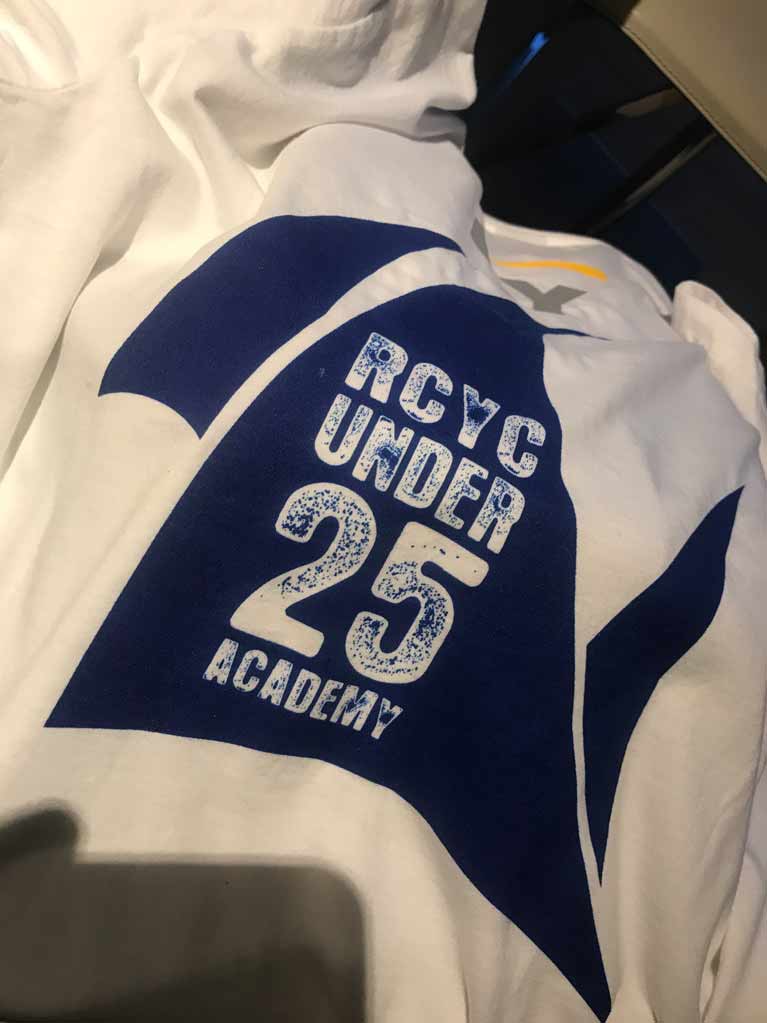 RCYC under 25 team gear
RCYC under 25 team gear
North Sails have been involved with the J-24 since its birth way back in the 70's and the sails have been heavily refined over that time. For more about the North Sails J-24 sail range please look here North J-24 Sail Range
Having said the above its not all about the J-24.........Many other classes are suitable such as the 1720 and the J-80. Both of these are used for Under 25 sailing and like any boat, they each offer a unique challenge in how to get the best out of them.
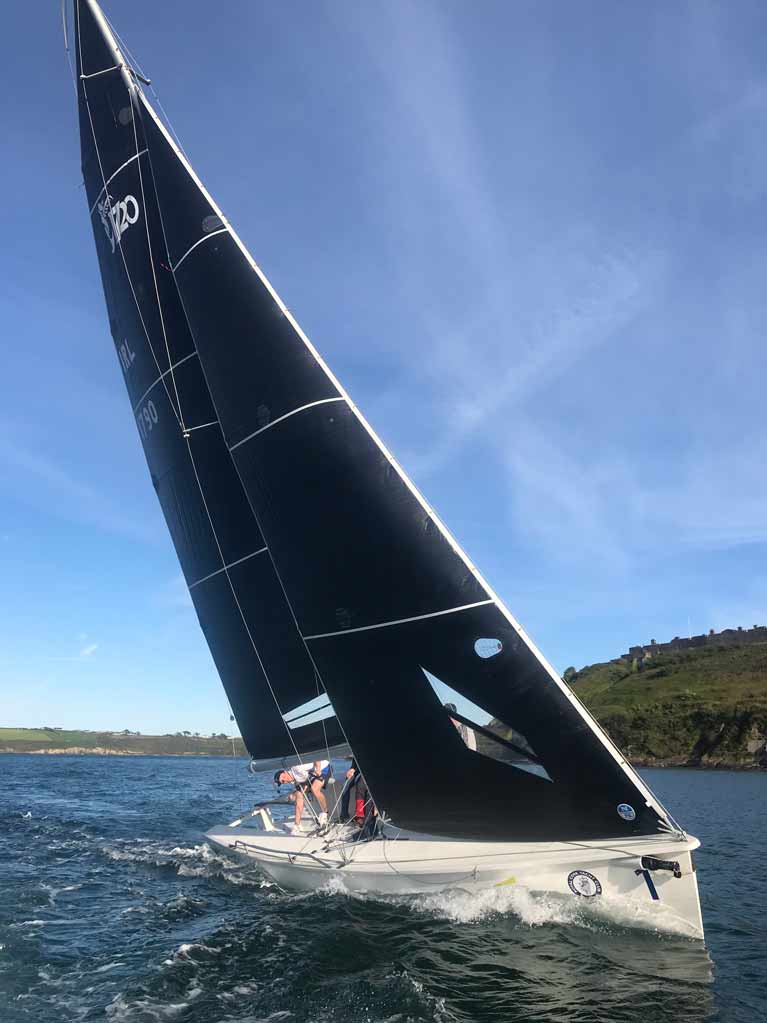 The under 25 1720 sporting North Sails
The under 25 1720 sporting North Sails
Short article here from earlier this year with the RCYC Under 25 squad and their 1720.
If you or your club are involved in under 25 sailing please do not hesitate to contact the North Sails Ireland Team if you need any help at all.
We look forward to training and racing against you all in 2020.
Sail FAST.
North Sails Ireland "Getting Better & Better" at the J109 Nationals
"North Sails have been powering "Joker II" since 2007. They just keep getting better and better and I have no doubt their latest 3Di Raw headsails have been a big factor in our success this year in the ICRA's, Volvo Dun Laoghaire Regatta and now the J109 Nationals. A big Thank You to Prof and the North Sails team for your fantastic support".
These were John Maybury's own words after claiming a third headline victory this year in his J109 "Joker II" at the National Championships in Dublin Bay last weekend.
Congratulations and RESPECT to the "Joker II" team - clearly a bunch of happy campers at the prizegiving - despite me photo bombing!
 Prof with the winning Joker II team at the J109 Nationals
Prof with the winning Joker II team at the J109 Nationals
They were pushed very hard by Pat Kelly's team on "Storm II" who, despite having a 1,3,1 score on day 2, could not quite close the gap. Awesome sailing though.
My teammates from the Scottish Series in May on "Chimaera" also put up a very strong consistent fight finishing third with a string of 2nds and 3rd in their scoreline.
 Chimaera flying her 3Di RAW mainsail and Code 2 Jib
Chimaera flying her 3Di RAW mainsail and Code 2 Jib
North Sails provided our ever popular red caps and gear bags as prizes for the event and I had a great time on the water coaching and facilitating the video de-brief afterwards on by BIG birthday - thank you to the J109 fleet for the cake!
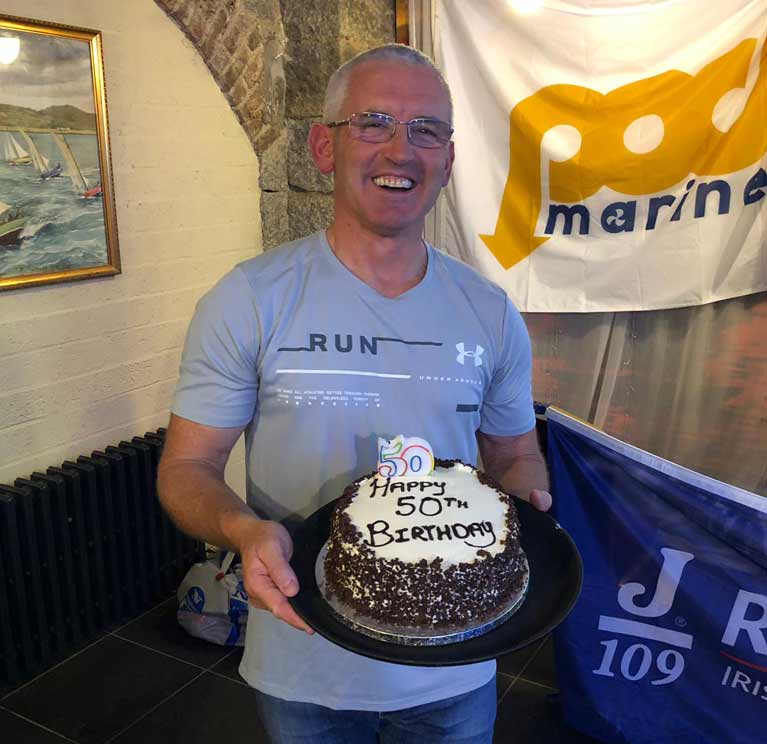 Happy Birthday! Prof celebrates after the J109 debrief at the RIYC
Happy Birthday! Prof celebrates after the J109 debrief at the RIYC
See you next Saturday at the Howth Autumn League and Sunday at the Royal Cork Autumn League!
From the North Sails Ireland team - Sail FAST.
North Sails Ireland Reports Fantastic ISORA Success, Winning Overalls & All Three IRC Classes
I was on Dun Laoghaire Marina and in the Royal Irish Yacht Club on Saturday night to greet both the JPK 1080 "Rockabill VI" and J122 "Aurelia" into Dun Laoghaire after the ISORA grand finale - the Pwhelli to Dun Laoghaire race writes Maurice O'Connell
Both teams were tired but in good form after the all-day sprint which culminated in a light air crawl for the last few miles. What a season-long effort by two tremendously well-prepared boats.
"Rockabill VI" won the series overall and "Aurelia" finished 2nd overall and both are powered by North Sails. They also finished 1st and 2nd in IRC 0. Fantastic job guys! It has been a pleasure and privilege for us to travel the ISORA journey with you!
I spoke with Paul after the race and here is what he had to say - "this year has been an amazing year for us winning the Dun Laoghaire Dingle Race, ICRAs, Calves Week and now the ISORA series. Kieran Tarbett, our helmsman loves our new 3Di Code 1 and Code 2 jibs! Our original 2016 3DL offshore mainsail that we use for ISORA continues to perform really well and of course, our "Leinster" A3 reaching kite is such a great sail. Massive thanks to the North Sails Ireland team for helping us achieve such success."
It was also good news for us in IRC 1. Last year's winner, Peter Dunlop and Victoria Cox's always competitive J109 "Mojito" won the class convincingly. This year the ISORA races tended, on average, to favour the bigger boats but "Mojito" hung in there really well all season, often in tough conditions. I swapped Whatapps with Peter and Vicky last night just after the final race. "Mojito" had been looking good to win it but the "shutdown" on Dublin Bay at the end, combined with a strengthening foul tide was a tough one for them. Well done though guys. You have been fantastically consistent over the past few ISORA seasons.
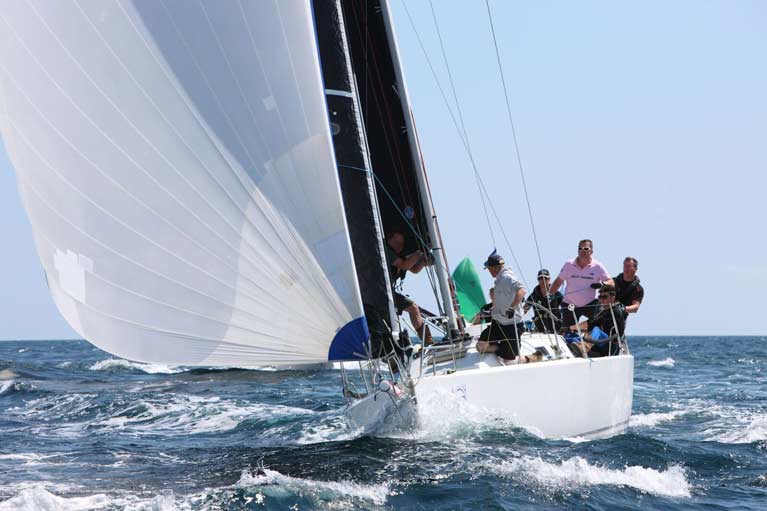 Mojito flying her North Sails Superkote A2 Asymmetric spi & North Sails 3Di Mainsail
Mojito flying her North Sails Superkote A2 Asymmetric spi & North Sails 3Di Mainsail
In IRC 2, Denis Power and Lindsay Casey's North Sails-powered J97 "Windjammer" repeated her 2018 victory by winning by a large margin from Joe Conway's Sigma 33 "Elandra" with Grzegorz Kalinecki's First 310 "More Mischief" in third. I raced with "Windjammer" few weeks ago, they are a top team and put a big effort into their ISORA racing.
 Aboard Windjammer flying her North Sails 3Di Offshore mainsail and North Sails 3Di Code 1 Jib
Aboard Windjammer flying her North Sails 3Di Offshore mainsail and North Sails 3Di Code 1 Jib
From the team here at North Sails Ireland, sincere congratulations and THANK YOU to all our ISORA customers. Your results are below:-
OVERALL
1. "Rockabill VI" JPK 1080 Paul O'Higgins NORTH SAILS*
2. "Aurelia" J122 Chris Power-Smith NORTH SAILS
IRC 1
1. "Mojito" J109 Peter Dunlop and Vicky Cox NORTH SAILS
2. "Daydreamer" J109 Paul Sutton NORTH SAILS
3. "Jetstream" J109 Nigel Ingram NORTH SAILS*
IRC 2
1. "Windjammer" J97 Denis Power and Lindsay Casey NORTH SAILS
2. "Elandra" Sigma 33 Joe Conway NORTH SAILS
3. "More Mischief" First 310 Grzegorz Kalinecki NORTH SAILS
*denotes partial inventory





























